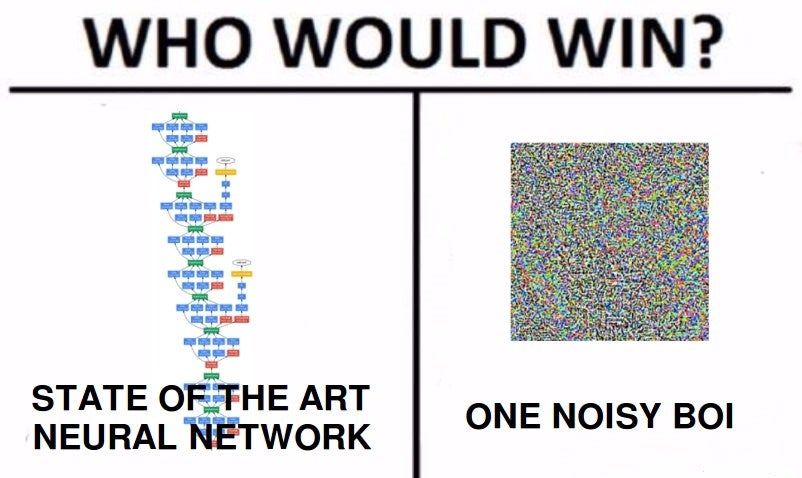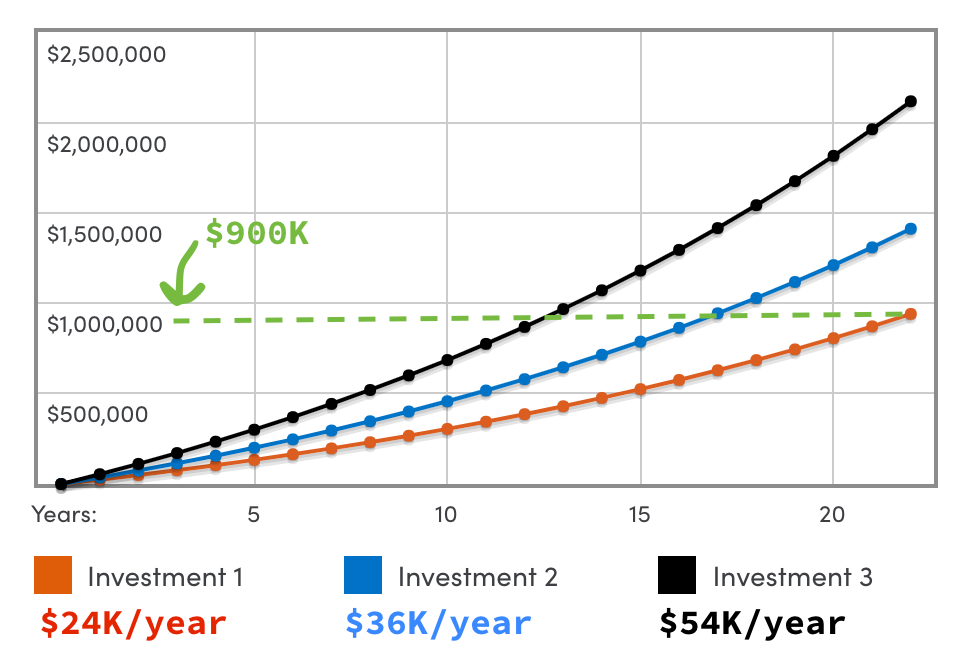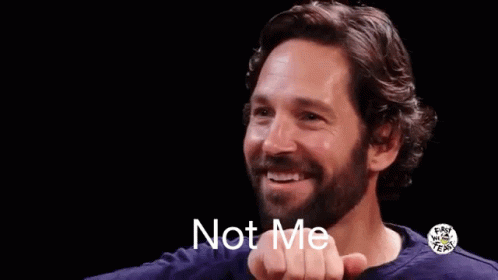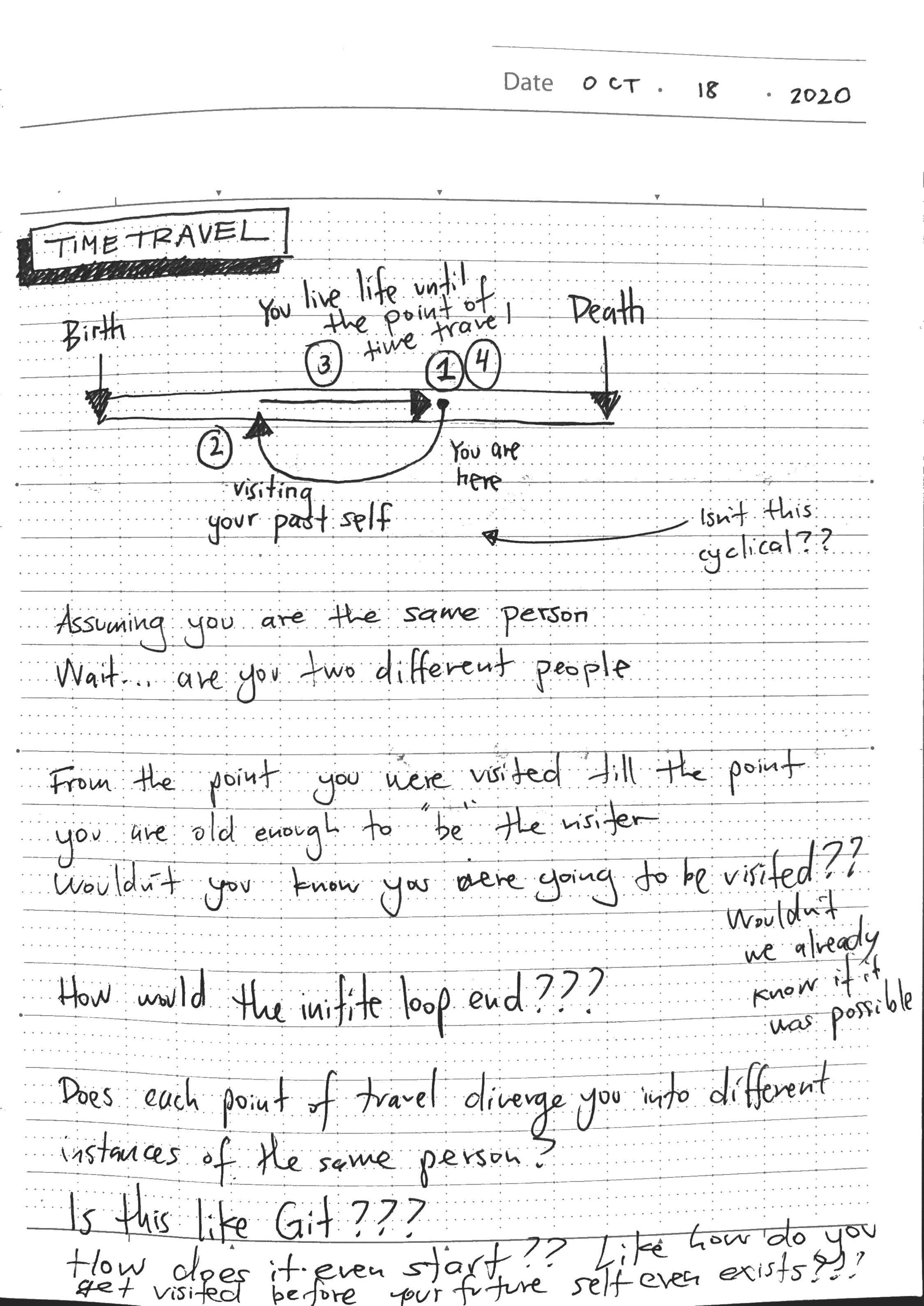The Scarcity Trap
You’re back where you started
It’s the same thing
You keep trying to do something different
Over and over again
Something has to change
I’ve been thinking about the NPR Hidden Brain podcast episode, The Scarcity Trap: Why We Keep Digging When We’re Stuck In A Hole.
Not having enough of what you need can become the only thing that matters to you.
It’s a great episode (a 30ish min listen); I’ve copied the last part on the scarcity of time from the transcript to make it easier for future reference.
VEDANTAM: Eldar Shafir and Sendhil Mullainathan believe that when something you desperately need is in short supply, your brain tends to focus on that thing. This focus can be so intense that it impedes your ability to think about anything else. What happens when the thing you’re missing is time, when you’re so busy it feels like you don’t have time to breathe?
…
Expand to continue reading the excerpt
VEDANTAM: Let me tell you the story of a young woman named Katie (ph). She asked us to use her middle name for reasons that will be clear in a moment. For as long as she can remember, Katie has been driven - really driven.
KATIE: When I was in high school, I was determined to be valedictorian. So I took a sophomore-level honors biology course as a freshman in high school. And I studied around the clock. I had note cards. I walked through the hallways with the note cards. If there was a holiday party, I brought the note cards. And I’d also study till 2 or 3 in the morning.
VEDANTAM: Katie says she wanted to be perfect at school. She eventually got to medical school, where she excelled. She graduated at the top of her class and quickly started her residency. The new schedule was grueling.
KATIE: You can get in at 5:30 or 6 in the morning, and you round on all your patients. And then you - you round with the team. That means you go to all the patients and check in on their plan and adjust medications, et cetera, as necessary. And then there’s usually a lunch conference, where we have education. And then in the afternoon, we might take new patients in and keep following up on our patients. And on some days, we get to leave at 4 p.m. Some days, we don’t leave till 1 a.m. (Laughter). So - and then you usually start the next day at 5:30 or 6 in the morning again. And you get one day off a week, usually work 80 hours-ish a week.
VEDANTAM: As Katie’s workload grew, she started to feel she couldn’t afford to waste a single moment. Instead of spending any time relaxing, she started to focus only on things directly related to her success at work.
KATIE: When I first started, it was just, like, really busy. So I’d try to come home, and I felt like, you know, I just don’t have a lot of hours. So I need to make the most of them and was like, OK, I need to make sure I’m exercising, keeping my body healthy. And I need to read and stay on top of things. So I’d come home after a pretty long day, and I might go walking for half an hour. And then I’d read. And then I’d go to sleep.
But then, as the time went on, I decided to try to get in more exercise ’cause I’m like, I never know when I’ll get enough exercise in. So I started spending all my free daylight hours walking or running outside or going to the gym, up to three hours a day, plus, like, working 15-hour days and then trying to read and then go to sleep.
VEDANTAM: As she focused intensely on the things she believed were key to her professional success, Katie lost sight of things on the periphery. She didn’t know it, but she was entering the tunnel of scarcity. In her case, it was scarcity brought on by a lack of time.
KATIE: So I wasn’t going to the grocery store. My house wasn’t unpacked yet. And it was stressing me out. And it was just a mess. And I’ve - my clothes piled up. I had a lot of dirty clothes. And coming home just felt so overwhelming. I didn’t want to be there. And that’s part of, I think, why I was walking so much, just to get out of the house and get away from all the things I hadn’t done. And I also forgot to pay a bill in the midst of all of this.
VEDANTAM: What did you forget to do? What bill did you forget to pay?
KATIE: It was my energy bill.
VEDANTAM: The old Katie would have spotted all of this. I mean, you were just basically, at this point, almost falling apart it sounds like.
KATIE: I was. I was falling apart.
VEDANTAM: There was something else. Katie had battled anorexia as a teenager. She knew she had to stay vigilant about her eating. But as she started to focus ever more intensely on work, she slipped back into some old habits.
KATIE: I was eating mostly vegetables and fruits. And I wasn’t eating a whole lot else, maybe a cliff bar here and there.
VEDANTAM: No one knows better than a doctor about the importance of nutrition. And yet, despite all of her medical training, Katie stopped taking care of herself. Here’s one thing I haven’t told you yet about scarcity. It can rob you of insight, insight about how your own mind is changing. Katie had no awareness that she was heading down a dangerous path. It became obvious to her only when it finally affected her work.
KATIE: I started to notice that I was, like, nearly missing things as I was reviewing. For example, I admitted a diabetic. And I almost didn’t order insulin for them. But I did order the insulin. But I was like, I don’t think I can keep up with this anymore because if you don’t give a diabetic insulin - especially if they’re Type 1 - they can have very fatal circumstances in the hospital and get really high blood sugars that can cause them to have an acidosis and end up on a ventilator. So I turned myself in at the point that I saw that it was starting to affect my work.
VEDANTAM: In two months of the residency program, Katie’s body and mind had withered. Things had gotten so bad, she had to go to a residential treatment center. Katie struggled with two things. Her body was desperately in need of nutrition. And her mind, she had to find a way to stop the intrusive thoughts that were consuming her. She had to…
KATIE: Learn how to just sit because we weren’t allowed to exercise. We weren’t allowed to stand. We weren’t even allowed to do jumping jacks or squats. We had to just sit.
VEDANTAM: Katie’s mind was filled with angry and impatient thoughts.
KATIE: At first, I felt like - I felt useless because I thought, you know, if I’m not doing something productive, what is my purpose in life?
VEDANTAM: But gradually, as the program literally forced her to do nothing, she started to emerge from the tunnel. She realized she had been so narrowly, relentlessly focused on one goal, doing well at work, that she had ignored the very things she needed to succeed - moments of relaxation, like watching TV or reading a book. Katie had loved art as a child. But she had put it aside because she thought it wouldn’t help her become a better doctor.
KATIE: I’m kind of the type of person that just likes to study and then do after I’ve, like, mastered it from a study point of view. And so to just do something without instruction is - it feels very vulnerable to me. But it ended up kind of being my saving grace in my recovery. And I’ve actually created an art room in my house. I changed my office from a work room into an art room. And it has paints and watercolors and chalks and everything you can imagine. And I try to go in there once a week and just create something without any expectation, just for the purpose of creating it because I can.
VEDANTAM: Katie eventually returned to her residency program with a new outlook. She started doing something that Eldar and Sendhil recommend to all busy people. She actually pencils time into her schedule to do nothing.
KATIE: One of the big things I’ve done is I kind of have a date night with myself once or twice a week, where I just schedule off the night. And I won’t do anything with anyone else. And it’ll just be free for me to do what I feel like. It might be watching a movie. It might be taking a soak in the tub and reading a book or being in my art room and painting whatever comes to me. But I do - like, I prioritize that. And I actually won’t accept plans with friends, generally, when I do this. So that’s one of the things I do.
VEDANTAM: Katie is consciously freeing up bandwidth. And something strange has happened as she’s done so. The less consumed she feels about work, the better she does at work.
KATIE: Honestly, like, it’s kind of incredible. But at work, my brain has increased its capacity fourfold. I am able to hold so many more things in my consciousness at once and manage them. I’ve just seen a really huge improvement in my ability to enjoy being in the company of others, to enjoy, like, occasions and to enjoy my work and do well at my work.
VEDANTAM: While the psychological studies into scarcity and bandwidth are relatively new, the ideas are actually ancient. Avoid tunnel vision. Keep difficult things in one part of your life from contaminating everything else. Be present.
MULLAINATHAN: Say you have a big deadline tomorrow for something you’ve got to finish. You go home, and you’re spending the evening with your kids. And in that moment, you’re not present-focused at all. What you’re focused on is that deadline. You - you may go through minutes where you didn’t hear what your kids were saying to you because your mind keeps going to this other thing.
VEDANTAM: Tunnel vision is not in itself a good thing or a bad thing. Shutting out distractions can be helpful at times. The question is, do you know when you’re inside the tunnel?
MULLAINATHAN: To me, that’s exactly the heart of managing scarcity. It’s recognizing when you’re trying to do something related to your scarcity where you really want to use that instinct. And when have you made a conscious decision to do something else where what you really need to do is to not have it intrude on that something else. You’re at home. You’re with your kids. You chose to be a parent for that three-hour period. You really don’t want scarcity to intrude then.
VEDANTAM: Of course, it’s easy to say, build free time into your schedule. Stay present with your family. Take a vacation. These strategies presume you have choices.
MULLAINATHAN: You can’t say, I’ve had it with being lonely. I’m going to take a vacation from being lonely. It’s not a choice. And to me, loneliness and poverty are the forms of scarcity that feel the biggest because while all these forces are at play, there’s no release valve. There’s no escape mechanism.
VEDANTAM: Eldar and Sendhil want policymakers to design solutions that recognize how scarcity creates traps from which many people may not be able to extricate themselves. And they want the rest of us to stop preaching to those in poverty.
SHAFIR: If you look at programs of poverty, we often confound a little bit the attempts to help the poor with the attempts to educate them, make sure that they show up on time, that they do the right things. From the perspective we’re taking with scarcity, in some sense, if I’m very busy juggling a very complicated life, insisting that I show up at the office at 8 and not 8:05 is not doing me a favor. I don’t need to be educated. It’s just hard to manage. I’m - you know, it’s just the transportation is not reliable. My kid is not ready. I don’t have a babysitter. I’m going to make mistakes. It’s not clear “educating me,” in quotes, about things is going to help me at all. It just makes my life all the more complicated.
VEDANTAM: When people in poverty fail or make mistakes, the researchers think we should respond to them the same way we respond to mistakes made by airline pilots. There was a time not long ago when we thought that airline pilots who made mistakes were just bad pilots. Sendhil says a big reason air travel has become safer in recent decades is that there has been a shift in thinking about such mistakes. Designers have made cockpits fault-tolerant. Rather than trying to find perfect pilots, cockpits are now designed to account for human error. The goal is to alert pilots when they’ve made a mistake and to diminish the consequences of mistakes.
MULLAINATHAN: It’s ironic that when we design cockpits, the entire mantra of fault tolerance seems so intuitive. But when we design social policies, nobody’s out there talking about, let’s make this fault-tolerant. I mean, you know, poor people have a lot on their mind. Their bandwidth is taxed. They’re going to make mistakes. Let’s make sure this program is robust when they do make that mistake. It’s just not the way we think.
If I offer a training program, I don’t sit there and say, let me make sure, you know, what’s going to happen? This is for low-income individuals. Surely, they’re going to miss a few days because, you know, it’s hard to get get to class sometimes or other things are on their mind. So let me design this curriculum so that it’s in-attendance (ph) tolerant. So even if somebody misses three days in a row, they’ll be able to come on that fourth day and still feel caught up. In fact, our training curriculum is often quite the opposite. If you miss three days in a row, it’s an invitation to miss the fourth day because you’re not going to get anything.
VEDANTAM: Brandy Drew eventually turned her life around. She found a low-income assistance program that offered her help. She worked with a financial counselor who gave her strategies for budgeting her money and keeping track of long-term priorities.
DREW: I actually have a calendar now that I write down everything to make sure I’m paying things on the correct day and time.
VEDANTAM: It’s taken time and little steps, but Brandy is no longer in the scarcity tunnel. She’s been working for two years now. And she has savings.
DREW: I know that if anything happens - God forbid, if I lose this job - I know that I can survive for at least six months if I have to look for another.
VEDANTAM: Eldar and Sendhil themselves say they are constantly trying to keep the lessons of scarcity front and center in their own lives. As a busy academic, Eldar has come up with a rule. When an invitation to an event two months down the road comes along, he asks himself whether he would attend the event if it were tomorrow. If the answer is no, he declines the invitation because his life is not going to be any less hectic two months from now.
Preserving bandwidth takes conscious effort. Most of us, Eldar included, are going to violate the Eldar rule. We’ll say yes to new commitments when we don’t have the time or pull out a credit card when we can’t afford it. In those moments, it’s important to look up to notice we are inside a tunnel.
Takeaways
I’ve highlighted some of the sections that stood out to me in the excerpt above. Gone unchecked, scarcity can easily trap us in this loop:
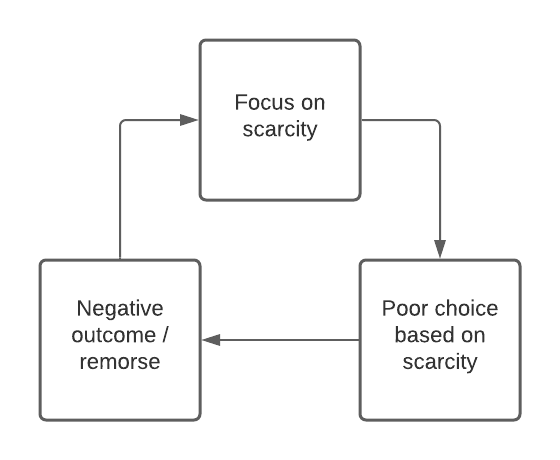
In hindsight, I can pin point times in my life I’ve been a scarcity thinker. The effects of scarcity also remind me of the impact of burnout I’ve felt, which I’ll probably write about in the future.
I’m trying to get better at identifying these feelings as they happen and effectively combat the lapses in judgement they can create.
